Physical Address
304 North Cardinal St.
Dorchester Center, MA 02124
Physical Address
304 North Cardinal St.
Dorchester Center, MA 02124
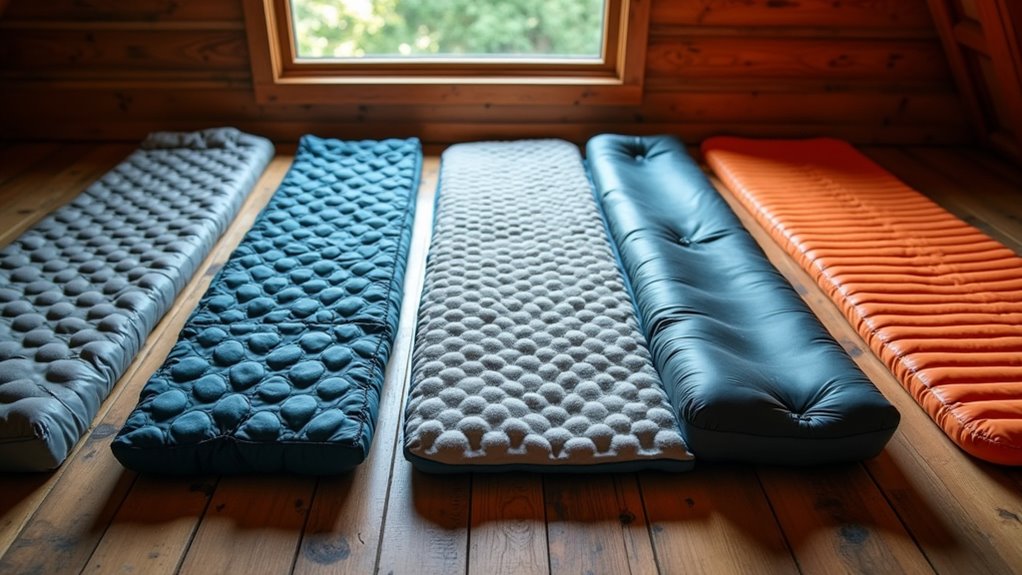
Selecting the perfect camping sleeping pad can transform your outdoor adventures from sleepless nights into cozy, rejuvenating experiences—but which features matter most?
Have you ever spent a night tossing and turning on the cold, hard ground, wondering why you skipped the sleeping pad? You’re not alone. When it comes to camping comfort, your sleeping pad choice can make or break your outdoor experience. It’s more than just a cushion between you and the earth—it’s your defense against cold temperatures and rough terrain. Before you invest in your next camping pad, you should consider the key factors that’ll guarantee peaceful nights under the stars.
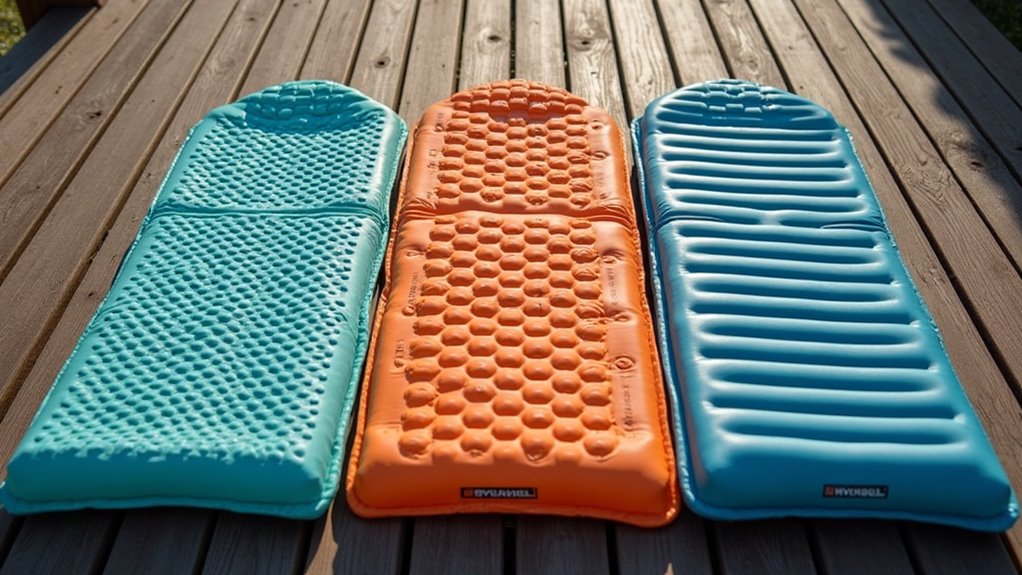
When choosing a sleeping pad for camping, you’ll encounter three main types: air pads, self-inflating pads, and closed-cell foam pads.
Air pads are your lightest and most compact option, making them perfect for backpacking. They offer excellent thickness and warmth, with models like the Therm-a-Rest XTherm NXT providing an impressive R-value of 7.3 for cold-weather camping. High-quality air pads feature quick-closing valves for convenient inflation and deflation. Essential sleeping bags are another important consideration for outdoor adventures.
Air pads pack small and weigh little, perfect for your backpacking adventures while keeping you cozy in the coldest conditions.
Self-inflating pads combine foam insulation with air chambers, offering a balance of warmth and comfort. While they’re less compact than air pads, they’re more durable and easier to set up.
Closed-cell foam pads are your most budget-friendly and maintenance-free option. They can’t deflate and last for years, but you’ll sacrifice some comfort and packability. These are ideal if you’re camping on a tight budget or need a reliable backup pad.
Since different camping styles demand specific gear requirements, selecting the right sleeping pad depends heavily on your preferred outdoor activities.
Car camping allows for thicker, heavier pads focused on comfort, while backpacking requires lightweight, compact options. Utilizing Triangular Core Matrix technology in air pads provides superior stability and heat retention for enhanced comfort. For winter expeditions, prioritize high R-value pads, but in summer, choose breathable options with lower insulation. When selecting a camping knife, it is important to follow safety guidelines to ensure proper and safe usage.
Remember to balance comfort with weight based on your specific needs, and don’t forget to factor in durability for long-term value.

Comfort and support are the cornerstones of a good night’s sleep outdoors, making certain pad features non-negotiable for campers. You should prioritize thickness first – look for pads that are at least 4 inches thick if you’re a side sleeper, as they’ll better protect your hips and shoulders from ground pressure. The dual air chambers in premium pads provide exceptional stability and support while preventing excessive bounce during movement. Make sure to bring a camping air mattress to ensure a comfortable sleeping experience.
Consider pads with built-in side rails to prevent rolling off during the night, and opt for materials that stay quiet when you move. Large rectangular shapes accommodate various sleeping positions, while stretch-knit fabrics conform to your body’s contours.
For durability, choose pads with at least 50-denier fabric, and check that the valves and seams are well-constructed. Remember that thicker pads often mean more weight and bulk, so balance comfort features against your carrying capacity.
Understanding R-value ratings is essential for selecting a sleeping pad that will keep you warm throughout the night. Higher R-values indicate better insulation, with ratings typically ranging from 1 to 7. You should match the R-value to your expected camping conditions and temperatures to guarantee comfort and safety.
Choosing the right R-value sleeping pad can mean the difference between a cozy night’s sleep and shivering until dawn.
Ground conditions and your personal temperature preferences will influence your ideal R-value. For maximum effectiveness, consider that R-values are additive when stacking multiple pads together. Camping pillows can also provide additional comfort and support for a good night’s sleep.
When choosing your pad’s R-value, consider your typical camping season, local climate, and whether you tend to sleep hot or cold. Remember, it’s better to have slightly more insulation than not enough.
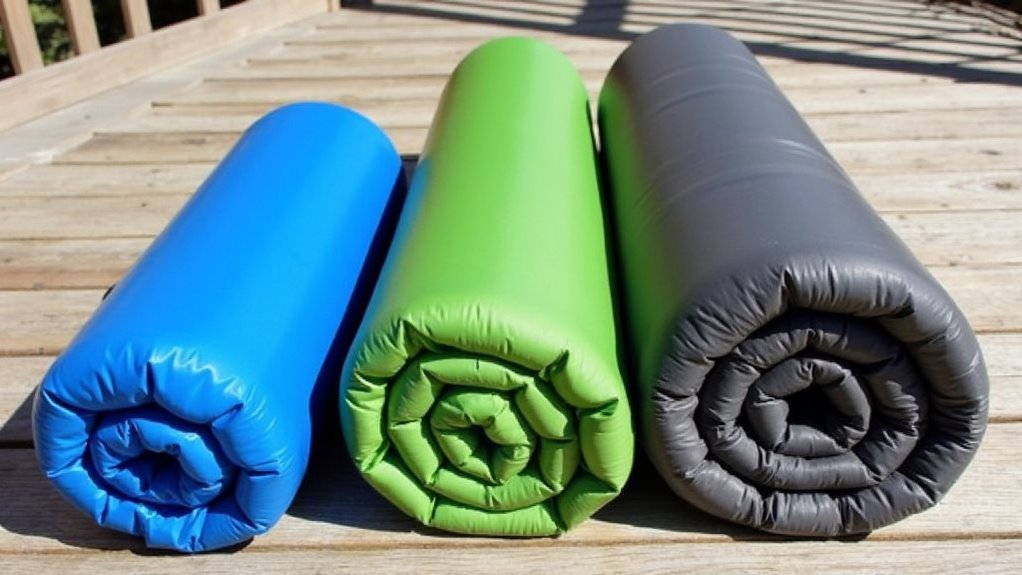
When selecting a sleeping pad for camping, weight and packed size can greatly impact your outdoor experience. For backpacking, you should prioritize ultralight pads under 1 pound, while car camping allows for heavier, more comfortable options.
Air pads offer the best weight-to-comfort ratio, compressing down to minimal sizes for easy packing. You’ll find most air pads provide up to 4 inches of cushioning thickness for superior comfort. If you’re trying to save weight, consider a mummy or tapered shape instead of rectangular, or opt for a shorter 3/4-length pad.
Standard width is 20 inches, but wider options (25-30 inches) add comfort at the cost of extra weight. Top camping mats for your outdoor adventures can provide additional insights on choosing the right sleeping pad.
Keep in mind that ultralight often means less durability and cushioning. You’ll need to balance weight savings against comfort needs based on your trip length and sleeping preferences.
For shared trips, a lightweight two-person pad might actually save weight overall.
While finding a lightweight pad is important, ensuring it can withstand regular outdoor use matters just as much. The Therm-a-Rest NeoLoft with its 50-denier polyester offers a good benchmark for measuring sleeping pad durability.
Look for pads made with higher denier ratings, like 75D polyester or nylon, as they’ll resist punctures better. Self-inflating pads with foam cores offer extra protection against leaks, while traditional foam pads provide unmatched durability without inflation risks. Essential Camping Gear for Every Outdoor Adventure should also be considered when choosing a sleeping pad.
Self-inflating and foam-core pads with higher denier fabrics offer superior protection against wear, making them ideal for rugged outdoor adventures.
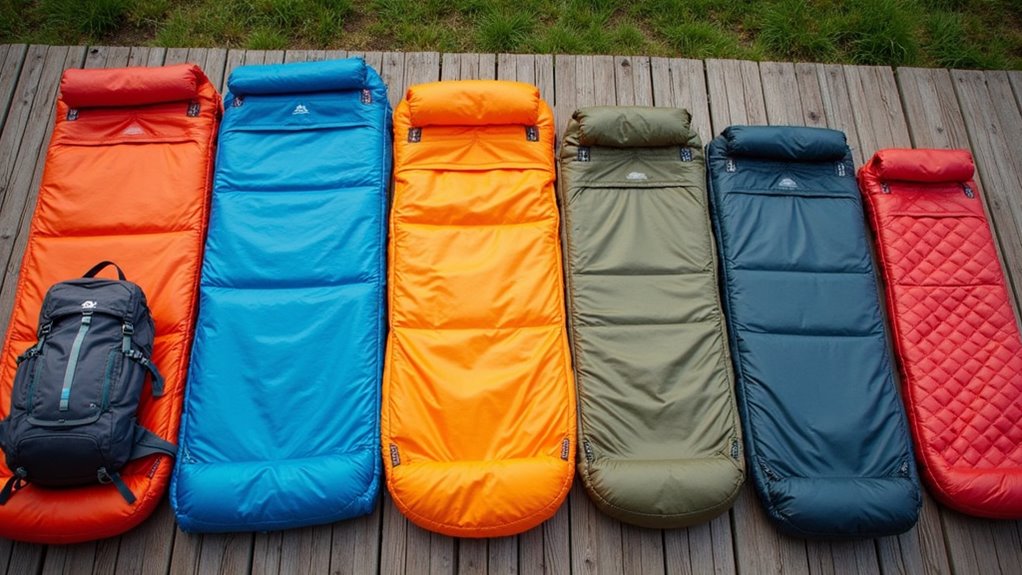
The right sleeping pad dimensions can make or break your camping experience. Standard pads measure 20 inches wide and 72 inches long, which works well for most campers. If you’re taller or prefer more space, consider a longer pad at 77-79 inches or a wider version at 25 inches. Regular-Wide size pads offer an excellent balance of length and width for those seeking extra comfort.
For ultralight backpacking, you’ll find shorter options at 47-48 inches that’ll save weight and pack space. Choosing the right camping sleeping bag is also crucial for your outdoor adventure.
You’ll need to balance comfort with portability – wider pads prevent rolling off but add bulk to your pack. When choosing dimensions, consider your tent size and sleeping style.
Thicker pads offer better insulation and comfort by keeping you elevated from the ground, while mummy-shaped designs can help reduce overall weight and volume without sacrificing essential coverage.
Now that you understand sizing requirements, selecting a high-quality sleeping pad within your budget becomes much clearer.
Your camping needs and weather conditions will determine which pad works best for you. The market offers excellent options across various price points and use cases. When evaluating sleeping pads, remember that a higher R-value indicates better insulation against cold ground. Choosing the right sleeping pad can make all the difference in getting a good night’s sleep while camping.
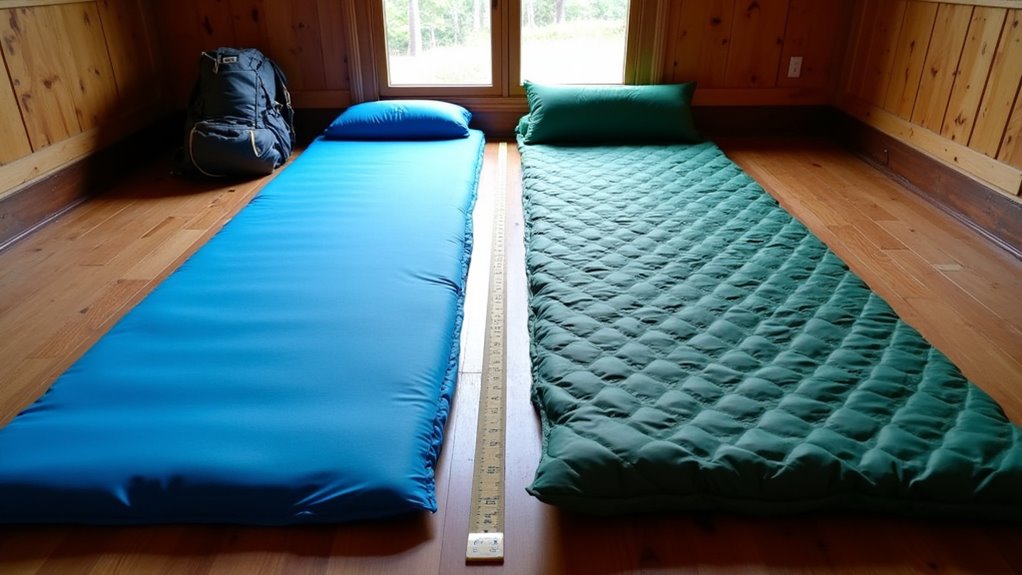
Choosing between budget-friendly and premium sleeping pads ultimately comes down to your camping frequency and specific needs.
If you’re an occasional camper or just starting out, budget options ($30-$100) like the Therm-a-Rest Z Lite Sol offer reliable functionality without breaking the bank. Understanding your sleeping pad R-value requirements is crucial for proper warmth and comfort in different weather conditions. Essential Camping Gear can provide a rundown of the essential items needed for a successful camping trip.
However, if you’re a frequent backpacker or face challenging conditions, premium pads ($150-$200+) deliver significant advantages. They’re remarkably lighter, more packable, and provide superior insulation through advanced materials and design. The NEMO Tensor All-Season, for instance, weighs just 14 oz while delivering excellent warmth and comfort.
Consider your priorities: Budget pads trade weight and comfort for durability and simplicity, while premium options optimize performance with enhanced insulation, ergonomic designs, and high-quality materials.
Your choice should align with your camping style and frequency.
Proper maintenance of your sleeping pad greatly extends its lifespan and performance while preventing costly replacements. To protect your investment, clean it with mild soap and a soft cloth after each trip, avoiding harsh chemicals that could damage the materials. Always make certain it’s completely dry before storage to prevent mold, and keep it in a cool, well-ventilated space away from direct sunlight. When cleaning, be especially careful to remove any insect repellent spills immediately to prevent damage to synthetic materials.
Choosing the right sleeping pad is an essential part of your camping gear. Inspect your campsite thoroughly for sharp objects before setting up your pad. Use a protective groundsheet or footprint underneath to prevent punctures. Don’t over-inflate the pad, as this can stress seams and lead to leaks. Address minor repairs immediately using proper patch kits. Store the pad loosely rolled rather than tightly folded to protect valves and seams.
Your perfect sleeping pad is like a home away from home, making the difference between restless nights and camping bliss. You should aim to match your camping style with the right type, considering R-value for warmth and packed size for portability. Don’t break the bank – there are quality options at every price point. With proper care and smart selection, you’re set for years of comfortable outdoor adventures.